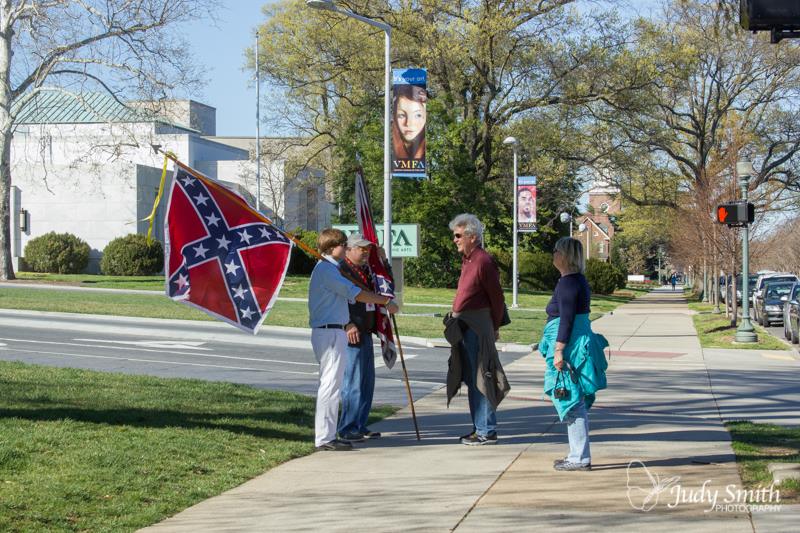
“Flaggers” protesting with Confederate Flags outside of the VMFA. | Photo courtesy of The Virginia Flaggers.
JUST A FEW BLOCKS from the statues of Confederate generals that line historic Monument Avenue, sits another piece of Richmond’s Civil War past: the unassuming, tiny white Confederate Memorial Chapel, a unique landmark nestled among the colorful townhouses in a quintessential Fan District neighborhood.

The Confederate War Memorial Chapel. | Photo by Brooke Harty.
THE CHAPEL IS ONE of the original buildings that remain from the R. E. Lee Camp and Confederate Soldiers’ Home, the first successful complex for poor and sick veterans of the Civil War. Dedicated on May 8, 1887, it represents the time of reconstruction that followed the bloody years of sectional conflict.
Although well-maintained today as a part of the perfectly manicured Virginia Museum of Fine Arts property, life-long Richmond resident and chapel docent Keith, told me personal stories from his childhood about playing baseball in the overgrown fields surrounding the chapel and never knowing what the tiny building was, despite growing up in the surrounding neighborhood.
Even today, Keith said that many visitors to the chapel are local residents who want to find out more about what the chapel is and its historical significance. From the cannon outside that was used during the siege at Fort Sumter, to the rare stained-glass windows featuring both Confederate and Union emblems placed there as symbols of post-war reconciliation, the tiny building is bursting with hidden nuggets of history.

One of the chapel’s stained-glass windows that depicts Confederate battle flags. All of the stained glass windows in the chapel are very rare. | Photo by Brooke Harty.
The chapel is also an important symbol to the active community of Confederate-soldier descendants still present in Richmond, who fight to preserve their personal family histories from 150 years ago. Until last summer, the Sons of Confederate Veterans (SCV) leased and ran the Confederate War Chapel from the Virginia Museum of Fine Arts (VMFA), but when SCV’s lease wasn’t renewed in May 2015, the arts museum took responsibility for running the chapel and keeping it open to visitors.
This change of hands led to disappointment within the SCV, who believe that the building and its ties to Civil War veterans begs for involvement from Confederate groups and organizations. Such is the strong, deep-rooted connection that many in the South have to their Confederate ancestors and the battles that they fought.
Just ask Dexter Oliver.
Oliver works as the genealogist for the Virginia Division of the Sons of Confederate Veterans. With his access to the records that contain details about all soldiers who fought in Virginia regiments, he helps many in the Richmond area find out “what their great great granddaddy did in the war,” he said.
The Confederate War Memorial Chapel is not new to the modern debate surrounding the use of Confederate symbols. Since 2010, when the VMFA decided the Confederate flag could no longer be flown over the chapel, members of SCV, sometimes referred to as “flaggers” have regularly staged protests outside the chapel over their right to fly the flag.
Now as the modern battle over the use of the Confederate flag continues to be waged in cities across the south, Dexter Oliver put into perspective for me what the flag means to him on a personal level. He said that when he looks at the flag, he is reminded of his ancestors fighting honorably in the war. “But I understand where other people look at it in a different light, especially minorities and what not, and I have to respect that too,” he said.
“What I don’t want to happen—and this is what the Confederate soldiers worried about—is that these symbols and emblems would be taken over by people like neo-Nazis and others who use it to keep people from enjoying life, liberties, and the pursuit of happiness that all Americans are entitled to.”
While there will always be conflicting opinions on what the Confederate flag represents, Oliver continues to help people find and commemorate their ancestors and the Civil War, keeping the memories and histories of these southern soldiers alive.
“Those people who do not understand and remember the past are destined to repeat the failures of the past,” he said.
By Brooke Harty
